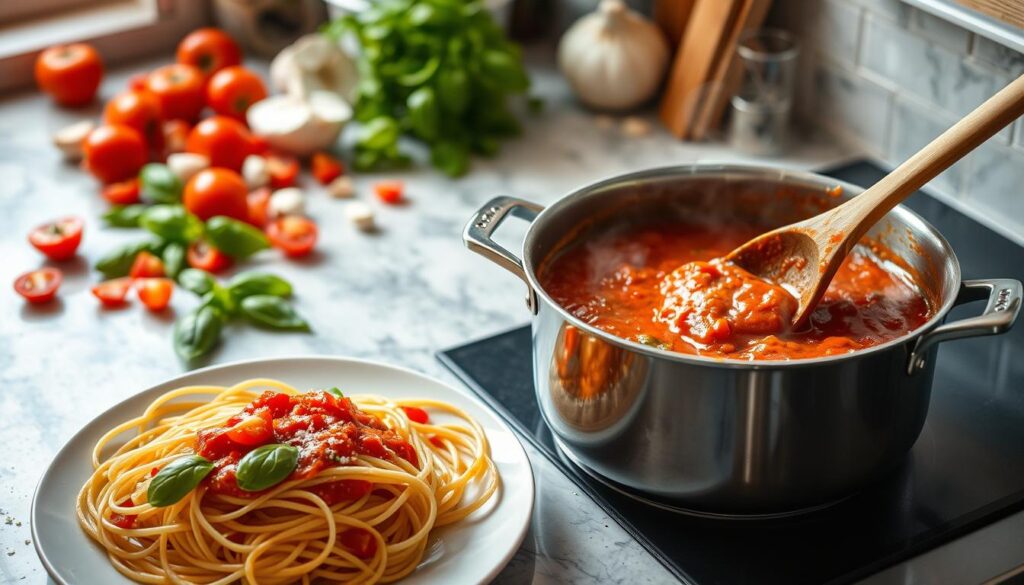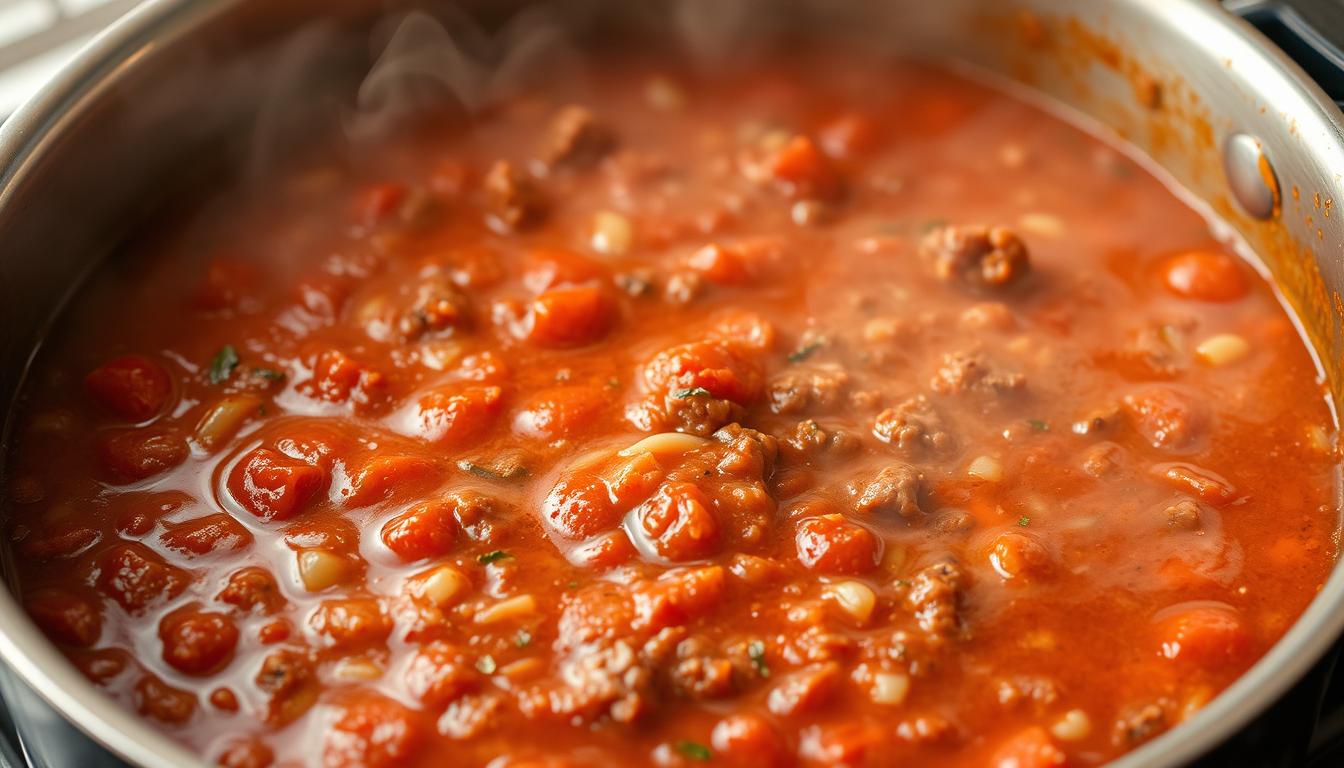Every time I start making fresh spaghetti sauce, I remember my grandmother’s cooking. The smell of tomatoes, herbs, and sauce fills the kitchen. It’s more than a meal; it’s a way to connect with our past through taste.
Making homemade spaghetti sauce is an art. It turns simple ingredients into something amazing. Homemade sauce beats store-bought any day, with its rich and vibrant flavors.
Creating the best spaghetti sauce at home is simple. You just need quality ingredients and a bit of passion. This guide will show you seven ways to make a delicious homemade sauce. It will impress your loved ones.
These methods work for anyone, whether you’re new to cooking or experienced. You’ll learn how to make a sauce that rivals restaurants. Get ready to enjoy making incredible homemade spaghetti sauce.
Understanding the Basics of Fresh Spaghetti Sauce
Making an authentic pasta sauce is like an art. It starts with knowing the basic parts. You need to understand the key ingredients and methods to make a tasty meal.
Essential Ingredients for Authentic Sauce
The best traditional spaghetti sauce comes from quality ingredients. Choose fresh, high-quality items to add flavor and richness to your dish.
- San Marzano tomatoes
- Extra virgin olive oil
- Fresh basil leaves
- Garlic cloves
- Kosher salt
- Black pepper
Common Mistakes to Avoid
Many home cooks make mistakes that ruin their sauce. Avoid these errors to make your sauce perfect:
- Never burn your garlic – it turns bitter instantly
- Avoid adding too much sugar
- Don’t rush the simmering process
- Use fresh herbs whenever possible
Equipment Needed
You don’t need fancy kitchen tools to make authentic spaghetti sauce. Most people already have what they need:
- Large stainless steel pot
- Sharp chef’s knife
- Wooden spoon
- Cutting board
- Blender or food mill (optional)
With these basics, you’re set to start making your own traditional spaghetti sauce. It will surely impress your loved ones.
Classic Marinara Sauce from Scratch
Making an easy spaghetti sauce recipe begins with the classic marinara sauce. This sauce is the base for many Italian dishes and can be ready in 20 minutes.
To make the perfect marinara sauce, you need a few ingredients and some basic steps. This sauce is loved for its simplicity and how it can be adjusted to taste.
- Fresh, high-quality canned tomatoes
- Extra virgin olive oil
- Fresh garlic
- Fragrant basil leaves
- Sea salt and black pepper
To start, sauté minced garlic in olive oil until it’s golden and smells great. It’s important not to burn the garlic, as it can make the sauce bitter.
| Ingredient | Quantity | Preparation |
|---|---|---|
| Canned Tomatoes | 28 oz | Crushed or whole, hand-crushed |
| Olive Oil | 3 tbsp | Extra virgin |
| Garlic | 4-5 cloves | Finely minced |
| Fresh Basil | 1/4 cup | Roughly chopped |
Then, add your tomatoes and let the sauce simmer for 15-20 minutes. Stir it a few times and crush the tomatoes to get the right texture. Finally, add fresh basil, salt, and pepper to taste.
Your homemade marinara sauce is great for pasta, pizza, or as a dip. Try different things to make it your own!
Rich and Hearty Meat-Based Sauce
Making a delicious spaghetti sauce with meat turns a simple pasta dish into a feast. Your homemade sauce can become a family favorite. This happens when you learn to mix and prepare meats well.
The key to a great meat sauce is picking the right mix of proteins. Chefs say mixing different meats creates deep flavors.
Choosing the Right Meat Combination
When making your meat sauce, think about these protein choices:
- Ground beef (80/20 lean-to-fat ratio)
- Italian sausage
- Pancetta
- Ground pork
Proper Browning Techniques
Browning meat is key for rich flavors in your sauce. Follow these expert tips:
- Make sure meat is at room temperature
- Use a heavy-bottomed pan
- Avoid overcrowding the pan
- Cook on medium-high heat
Simmering Times and Tips
A delicious spaghetti sauce needs patience. Slow simmering blends flavors and makes them stronger.
| Meat Type | Recommended Simmering Time |
|---|---|
| Ground Beef | 1-2 hours |
| Italian Sausage | 2-3 hours |
| Mixed Meats | 3-4 hours |
The secret to an exceptional meat sauce is low and slow cooking.
Traditional Italian Tomato Basil Sauce
Making an authentic pasta sauce is all about simplicity. The traditional Italian tomato basil sauce uses fresh ingredients and keeps things simple. San Marzano tomatoes are the best choice for a sauce that truly captures Italian flavors.
Here are the key things to focus on when making your sauce:
- Select ripe, high-quality San Marzano tomatoes
- Use fresh basil leaves picked just before cooking
- Cook the sauce briefly to preserve fresh flavors
- Use extra virgin olive oil for richness
“Simplicity is the ultimate sophistication in Italian cooking” – Unknown Italian Chef
The secret to a great pasta sauce is respecting each ingredient. Your sauce should be bright and light. Let the tomatoes’ natural sweetness and the basil’s aroma be the stars. Don’t overcook, as it can ruin the sauce’s vibrant flavors.
Experts say to use whole peeled San Marzano tomatoes, crushed by hand for texture. Add fresh basil leaves to the sauce in the last minute of cooking. This keeps their flavor strong. It’s how you stay true to Italian cooking traditions.
Fresh Spaghetti Sauce with Garden Tomatoes
Making homemade spaghetti sauce with fresh garden tomatoes turns a simple meal into a feast. The fresh taste of sun-ripened tomatoes adds a special depth to your sauce. This is something store-bought sauces can’t offer.
To make the best homemade spaghetti sauce, start with the right tomatoes. Your garden’s tomatoes can be turned into a delicious sauce with a little effort and patience.
Selecting the Perfect Tomatoes
When picking tomatoes for your sauce, look for these traits:
- Ripe, deep red color
- Firm but slightly soft to touch
- Heavy for their size
- No blemishes or soft spots
Blanching and Peeling Techniques
To prepare fresh tomatoes, follow this blanching method to remove skins easily:
- Cut a small X at the bottom of each tomato
- Boil water and prepare an ice bath
- Submerge tomatoes in boiling water for 30-60 seconds
- Immediately transfer to ice water
- Peel skin starting from the X mark
Seasoning Your Garden-Fresh Sauce
Fresh tomatoes need careful seasoning to bring out their flavors. Start with these key ingredients:
| Ingredient | Quantity | Purpose |
|---|---|---|
| Fresh Basil | 1/4 cup, chopped | Adds bright, herbal notes |
| Garlic | 3-4 cloves | Provides depth and aroma |
| Olive Oil | 2 tablespoons | Enhances flavor and texture |
| Salt | To taste | Balances and intensifies flavors |
Remember, fresh tomatoes have more water, so your sauce might need longer cooking. Patience is key to developing rich, concentrated flavors.
Quick 30-Minute Sauce Recipe

Craving a delicious quick spaghetti sauce but short on time? You’re in luck! This easy spaghetti sauce recipe will make your weeknight dinner amazing in just 30 minutes.
The secret to a fantastic quick spaghetti sauce is using top-notch ingredients and smart cooking. Start with a base of premium canned crushed tomatoes. They give you rich, authentic flavor without hours of cooking.
- Grab a large skillet with deep sides
- Use extra virgin olive oil for depth of flavor
- Choose ripe, high-quality canned tomatoes
- Keep fresh garlic and dried herbs on hand
Your quick spaghetti sauce can get a flavor boost with simple add-ins. These add-ons pack a lot of flavor in no time. Try these fast flavor boosters:
- Fresh basil leaves
- Grated Parmesan cheese
- Red pepper flakes
- Minced garlic
Pro tip: Let your sauce simmer for 15-20 minutes to get deeper flavors. Stir occasionally and taste, adjusting seasonings as needed. You’ll get a restaurant-quality sauce that tastes like it’s been cooking all day.
“Great sauce doesn’t need hours – it needs intention and quality ingredients.”
Slow-Cooked Sunday Gravy
Sunday gravy is at the heart of Italian-American cooking. It turns a simple meal into a family event, filled with rich flavors and memories. Once you learn to make it, your weekends will never be the same.
The secret of traditional spaghetti sauce is its slow cooking. Unlike fast weeknight meals, Sunday gravy needs patience and love.
Selecting the Perfect Meats
Your Sunday gravy should have different meats for depth and complexity:
- Pork ribs
- Italian sausage
- Beef braciole
- Meatballs
Cooking Timeline and Temperature Tips
To make a great spaghetti sauce, pay attention to cooking techniques:
- Brown meats at high heat first
- Then, lower the heat to a low simmer
- Cook for 3-4 hours at least
- Stir now and then to avoid sticking
Keep the heat gentle and steady. This lets the flavors blend well without burning the sauce.
“Great sauce takes time, love, and attention to detail.” – Nonna’s Kitchen Wisdom
Storing and Preserving Homemade Sauce
Making homemade spaghetti sauce is a big job. To keep your hard work fresh, you need to store it right. With the right methods, you can keep your sauce tasty for your pasta dishes.
Here are the main ways to keep your sauce fresh:
- Refrigeration: Store in airtight containers for up to 5-7 days
- Freezing: Preserve sauce for 3-4 months with proper packaging
- Canning: Long-term preservation for shelf-stable sauce
To store in the fridge, cool your sauce first. Use glass containers to keep flavors in and prevent taste mixing. Make sure to leave some space at the top for expansion.
Freezing needs careful steps. Use containers or bags safe for the freezer. Pro tip: Divide your sauce into portions for easy thawing and less waste. Mark each container with the date to keep track of freshness.
For canning, follow food safety rules closely. Sterilize jars and use a water bath or pressure canner. This way, you can enjoy your sauce months later.
Remember, proper cooling and storage are key to maintaining the rich flavors of your homemade sauce.
Wine Pairing and Serving Suggestions

Enhancing your pasta sauce experience is more than cooking. The perfect wine and pasta shape can turn a simple meal into a feast. Learning to pair them well will make your dining experience unforgettable.
Perfect Wine Selections for Your Sauce
Finding the right wine can really boost your spaghetti sauce’s flavors. Each sauce type needs a special wine:
- Marinara Sauce: Light-bodied red wines like Chianti or Sangiovese
- Meat-Based Sauce: Robust reds such as Cabernet Sauvignon or Zinfandel
- Vegetarian Sauce: Medium-bodied wines like Pinot Noir
Pasta Shape Recommendations
The texture of your sauce should guide your pasta choice. Each shape interacts uniquely with different sauces:
- Chunky sauces pair best with ridged pasta like rigatoni
- Smooth sauces work wonderfully with spaghetti or linguine
- Thick meat sauces complement pappardelle or fettuccine
Pro tip: Serve your pasta right after mixing with sauce. This keeps the texture and temperature just right.
Herb and Spice Combinations
Making a tasty spaghetti sauce is like art. It starts with knowing the power of herbs and spices. The right mix can turn your sauce from good to great.
Italian cooking loves a wide range of herbs. They add depth and personality to sauces. Here are some classic herb mixes:
- Basil – a sweet, peppery herb that adds bright flavor
- Oregano – provides an earthy, slightly bitter note
- Parsley – offers a fresh, clean taste
- Red pepper flakes – for those who enjoy a spicy kick
Here are some tips for picking herbs and spices for your sauce:
- Choose fresh herbs for the best taste
- Put dried herbs in early to let flavors meld
- Add fresh herbs just before serving to keep their flavor bright
- Try new mixes like fennel seeds or thyme
By knowing how herbs work together, you can make your sauce stand out. Begin with Italian classics, but feel free to mix things up.
“Herbs are the soul of cooking – they transform simple ingredients into memorable meals.” – Italian Cooking Wisdom
Remember, balance is everything. Start with a little of each herb and spice, tasting as you go. Every pinch can change your sauce’s flavor.
Troubleshooting Common Sauce Issues
Making the perfect homemade spaghetti sauce can be tough, even for pros. Knowing how to solve common sauce problems helps you make a sauce that wows everyone.
Creating a tasty sauce takes time and effort. Most problems can be fixed with a few easy steps. These steps turn a good sauce into a top-notch one.
Fixing Texture Problems
Texture is key in your homemade spaghetti sauce. Here are some quick fixes:
- Watery Sauce: Simmer uncovered to reduce liquid and concentrate flavors
- Thin Consistency: Add tomato paste or grated cheese to thicken
- Grainy Texture: Blend sauce with an immersion blender for smoothness
“The secret to a perfect sauce is patience and understanding your ingredients.” – Italian Cooking Wisdom
Balancing Flavors
A great sauce comes from balanced flavors. Here are tips to fix flavor issues:
- Too Acidic: Add a pinch of sugar or grated carrot
- Bland Taste: Enhance with fresh herbs or a splash of red wine
- Bitter Notes: Incorporate butter or olive oil to soften harshness
Every sauce is a chance to learn. Don’t hesitate to try new things and listen to your taste buds.
Conclusion
Making the perfect traditional spaghetti sauce is like creating art. It turns simple ingredients into something magical. Your kitchen becomes a place where flavors mix and memories are made.
Whether you’re new to cooking or have years of experience, this guide will help you improve. You’ll learn how to make sauces that are truly special.
The secret to the best spaghetti sauce is passion, practice, and a willingness to try new things. You’ve seen different ways to make sauce, from quick recipes to slow-cooked ones. Each method lets you create a sauce that’s uniquely yours.
Remember, making sauce is a journey. Start with these basic recipes, but feel free to add your own twist. Using fresh herbs, quality ingredients, and patience will help you make an amazing sauce.
Your sauce-making adventure is just starting. Be open to new things, trust your taste, and enjoy the tasty results. With time, you’ll make sauces that impress everyone at your table.

